| Designation: | MTVL |
 |
|---|---|---|
| Manufacturer: | BAE Systems Land and Armament | |
| Product type: | Armoured Vehicles | |
| Name: | Tracked armoured personnel carrier |
The Mobile Tactical Vehicle Light (MTVL) was developed by the now BAE Systems, Ground Systems Division (at that time United Defense) as a private venture with the first prototype being completed at its San Jose facility in 1994.
The company is offering the MTVL as a new build vehicle or a conversion of existing M113 series vehicles.
The prototype is based on an existing M113 series vehicle to demonstrate that such a conversion is possible.
According to the company, the MTVL has 70 per cent more payload capacity, 30 per cent more volume under armour and 50 per cent greater cross-country mobility than the latest production M113A3.
The additional payload and volume under armour creates essentially a heavy APC variant based on the M113 chassis.
When mounting a one- or two-man weapon station and fitted with additional armour, the chassis is the basis for the BAE Systems, Ground Systems Division Infantry Fighting Vehicle Light, covered in detail in a separate entry.
As of mid-2007 this remained at the prototype stage. When fitted with the complete turret of the BAE Systems, Ground Systems Division, Bradley M2 IFV the complete vehicle was called the Egyptian Infantry Fighting Vehicle. A prototype of this has been built and tested but as of mid-2007 no production orders had been placed for this vehicle.
The MTVL was designed by BAE Systems, Ground Systems Division to provide continued growth capability for the M113 series of vehicles beyond the capabilities of the world-renowned M113A3.
By early 1998, a total of six MTVL vehicles had been built, all of which were conversions of existing vehicles.
The first was the prototype MTVL and also used for the Combat Engineer Squad Vehicle, the second was for the Egyptian Infantry Fighting Vehicle Light programme and numbers three, four, five and six were for the Canadian M113APCLE (Armoured Personnel Carrier Life Extension).
The first Canadian M113APCLE was rolled out at the now BAE Systems, Ground Systems Division San Jose facility in January 1998. This was completed in 106 working days. Additional details of the M113APCLE are given under Canada.
The Canadian version of the MTVL is the first vehicle to be equipped with the new Detroit Diesel 6V-53TIA series Detroit Diesel Electronic Control (DDEC) IV electronic engine which allows the user to electronically tune the engine to a desired rating up to 400 hp.
The MTVL and variants MTVE, MTVR, MTVC and MTVF have been built to meet the requirements of Canada with a total of 147 being supplied. Additional details are provided under Canada.
In early 2002, two MTVL vehicles were built as bid samples for the US Army's Interim Armored Vehicle (IAV) programme. These two vehicles were configured as personnel carriers and were armed with the RAFAEL Armament Development Authority .50 (12.7 mm) remote-control weapon station. A more detailed description of the MTVL IAV is provided in a separate section later in this entry.
In 2000, the company built two prototype M58E smoke vehicles based on the MTVL chassis as an upgrade to the M58 Wolf to take advantage of the large interior volume. These two vehicles completed just under 16,000 km of testing.
The MTVL is essentially an M113 APC with a new lower hull configured for the six road wheel high-mobility suspension and an uprated power pack that features the NATO-approved electronically controlled Detroit Diesel 6V-53 TIA, turbocharged, intercooled and after-cooled engine that develops 400 hp.
The hull is of all-welded 5083 aluminium armour which provides protection from small arms fire and shell splinters. An add-on optional armour package is available that is understood to provide protection against attack from 30 mm armour-piercing projectiles over the frontal arc. Details are as follows:
Upper and lower front glacis and sides-titanium/steel appliqué
Bottom-spaced laminate steel
Upper front glacis and sides - armour tiles.
The driver is seated at the front left and has a single-piece hatch cover that opens to the rear and to his front and left side are four M17 day periscopes with provision for an AN/VVS-2 passive night vision device of the image intensification type or an AN/VAS-5 thermal type.
The engine compartment is to the right of the driver's position and is fitted with a fire extinguishing system that can be operated by the driver or from outside the vehicle. An automatic fire-suppression system is available and was installed in the IAV bid sample vehicles. The air inlet and outlet louvres and the exhaust pipe outlet are in the roof and there is an engine compartment access door that opens upwards in the front of the sloping glacis plate.
The commander is seated to the rear of the engine compartment and has a cupola that can be traversed through a full 360°, five M27 day periscopes and a single-piece hatch cover.
The standard armament is pintle-mounted on the forward part of the commander's cupola and can be a .50 (12.7 mm) M2 HB machine gun, 40 mm MK 19 Mod 3 grenade launcher or 7.62 mm M240 machine gun.
If the .50 (12.7 mm) M2 HB machine gun is fitted then elevation limits are from -21 to +53° with traverse through a full 360°. There are 100 rounds of ready use ammunition carried for this weapon. Mounted either side of the hull, firing towards the front, is a bank of four electrically operated grenade dischargers.
The infantrymen sit on bench seats that run down either side of the hull facing the centre and enter and leave via a large power-operated ramp in the hull rear. There is also a door in the left side of the ramp.
Over the top of the troop compartment is a large roof hatch that opens to the rear and to the rear of this is a domed adjustable ventilator.
The torsion bar suspension either side consists of six dual rubber-tyred road wheels with the drive sprocket at the front and the idler at the rear. There are no track-return rollers. The vehicle can be supplied with the T130 or T150 series track.
Compared to earlier versions of the M113 series, the idler and drive sprocket of the MTVL have been repositioned and the reconfigured suspension geometry gives more than 389 mm of road wheel travel.
Although the basic MTVL is configured as an armoured personnel carrier, it can be configured for a wide range of other battlefield support roles. The MTLV and its variants are roll-on/roll-off air-transportable in a Lockheed Martin C-130 Hercules.
The diesel fuel tanks of the MTVL can either be in external diesel fuel tanks one either side at the rear as normal or under the floor of the vehicle in special fuel cells designed not to rupture in an anti-tank mine blast. Both external and internal fuel tanks can be mounted for a total fuel capacity of 200 US gallons (757 litres). The Canadian vehicles have the diesel fuel cells under the floor of the vehicle. As with all members of the M113 family of tracked vehicles, a wide range of optional equipment is available including spall liners, mine protection, NBC system (ventilated face piece, overpressure or regenerative), swim kit, firing ports, automatic fire suppression and air conditioning system.
For the Canadian M113LE programme, the now BAE Systems, Ground Systems Division has developed a recovery vehicle based on the MTVL chassis in order to provide a recovery capability for units equipped with light armoured vehicles. The MTVR shares all automotive components and mobility characteristics with the MTVL.
Vehicle recovery operations are performed using a 20,000 kg single line pull hydraulically operated winch, rear-mounted spades with a centre blade, personnel safety shield and the necessary mounted and stowed equipment for recovery operations.
The winch is mounted in the cargo area just forward of the ramp door. For difficult recovery operations, two ground spades, one on each side of the ramp, are easily deployed to stabilise the vehicle.
Equipped with a Protected Weapon Station, the MTVR provides under armour firing capability to its commander for the C6 7.62 mm light machine gun. Two banks of four electrically fired 76 mm multipurpose grenade launchers are mounted on the front glacis plate. These can fire a variety of munitions including smoke, white phosphorous and fragmentation.
The MTVR carries a basic crew of three (driver, vehicle commander and an additional technician). The first prototype of the MTVR was completed in early 2002 with Canadian production of the vehicle commenced late the same year.
The MTVR can be further enhanced by the integration of a crane to assist with repair operations in the field. A total of 23 units have been supplied to Canada.
The MTVE incorporates the Canadian Specially Equipped Vehicle (SEV) kit into the MTVL chassis and entered production in Canada in 2002. All of the Canadian MTVE vehicles are being converted from existing M113 SEV vehicles. A total of 28 units are being supplied to Canada.
The MTVE provides integral light bulldozer, hydraulic auger and power-tool capability to combat engineer sections in support of mechanised combat arms operations.
Equipped with a Cadillac Gage/Textron Marine & Land Systems power-assisted 12.7 mm (.50 cal) turret, the MTVE provides under armour firing capability for the vehicle commander for both the .50 (12.7 mm) heavy machine gun and the C6 7.62 mm light machine gun. Two banks of four electrically fired 76 mm multipurpose grenade launchers can fire a variety of munitions including smoke, white phosphorous and fragmentation.
The MTVE carries a crew of two, driver and vehicle commander, and can accommodate an engineer section of eight soldiers with winter gear and rucksacks.
The MTVC variant of the MTVL has been developed and produced for the Canadian M113LE programme to transport supplies, equipment and ammunition pallets in support of combat operations. It provides improved cargo carrying capabilities over the standard production M548 and provides autonomous material handling capability with the addition of the crane.
The cargo carrier provides the same crew compartment armour protection as the MTVL, which is a major improvement over the thin-skinned M548.
The MTVC is a flatbed version of the MTVL chassis with the suspension, power pack and fuel system common to the MTVL. The MTVC has the same mobility characteristics as the MTVL.
The MTVC provides a hydraulically operated crane, cargo bed with armoured fold-down sides and a tailgate. The crane, which has a load capacity of 1,590 kg at a reach of 6.3 m, is mounted at the rear of the cab. The vehicle can also be equipped with two large sliding storage drawers to carry personal gear and other on-vehicle equipment.
The commander's seat has been moved towards the vehicle curbside to facilitate crane integration and operation. A jump seat is located behind the driver's station and can be used to transport an additional crew member.
In addition to the driver's hatch and commander's cupola, a door on the right side of the cab provides added access to the crew compartment as well as an emergency egress.
A prototype of the vehicle was completed at the now BAE Systems, Ground Systems Division Santa Clara facility in June 2000 and completed an 8000 km test in July 2000. Production of 53 vehicles for Canada commenced in 2002.
The MTVC can easily be converted into the MTVF configuration as covered below. All components that differentiate the MTVC from the MTVF are bolt-on components.
The MTVF is essentially the MTVC except that it has thicker cargo bed plates and is equipped with storage cabinets, generator, compressor and air tools, so that it is more suited for fitter and repair roles.
There is available space in the cargo bed to hold an MTVL power pack in its container. Using the same crane as the MTVC, the MTVF will be used to transport and replace major assemblies, including power packs and weapon stations, in the field.
Equipped with a Protected Weapons Station (PWS), the MTVF provides under armour firing capability to its vehicle commander for the C6 7.62 mm light machine gun.
The MTVF prototype was converted from the prototype MTVC vehicle at the DEW Engineering Ltd facilities in Ottawa. It was completed in early 2002, with production started at the Canadian Army Workshop Depot in Montreal.
Canada is taking delivery of a total of 36 vehicles.
In conjunction with the design and testing of a Band Track for the M113, Band Track has been developed, and testing on the MTVL commenced in March 2001.
The rubber Band Track offers the user a number of significant advantages over conventional tracks, including a reduction in vibration, infra-red signature, reduction in noise and weight. During trials the Band Track also gave an improvement in traction as well as reducing rolling resistance. Expected life of the rubber Band Track exceeds 19,000 km. The rubber band track is already in service with Norway on its M113 series vehicles.
Shown for the first time in September 1995 was the second example of the 120 mm Armored Mortar System (AMS) installed on the chassis of the Mobile Tactical Vehicle Light (MTVL) full-tracked armoured vehicle.
Production of the first-generation AMS has been completed and details are given in a separate entry.
The Combat Engineer Squad Vehicle (CESV) has been proposed to the US Army Engineers. It is based on the current in-service M113A3 series APC and would be rebuilt to expand its internal volume. In many respects the CESV is identical to the MTVL.
For trials purposes an MTVL has been fitted with the complete commander's cupola from the General Dynamics Land Systems M1 MBT. This is referred to as the M113 Protected Weapon Station (PWS) and is armed with an externally mounted .50 (12.7 mm) M2 machine gun, which can be aimed and fired from under armour.
To meet the US Army requirement for an Interim Armoured Vehicle, the then United Defense offered a number of variants based on the MTVL chassis.
|
||||||||||||||||||||||||||||||||
|
|||||||||||||||
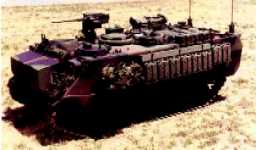 |
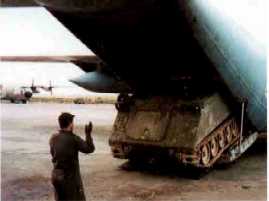 |
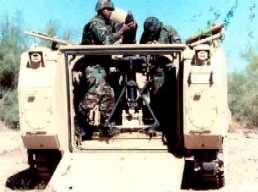 |
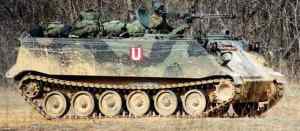 |
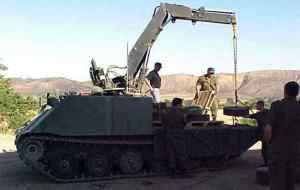 |
 |
